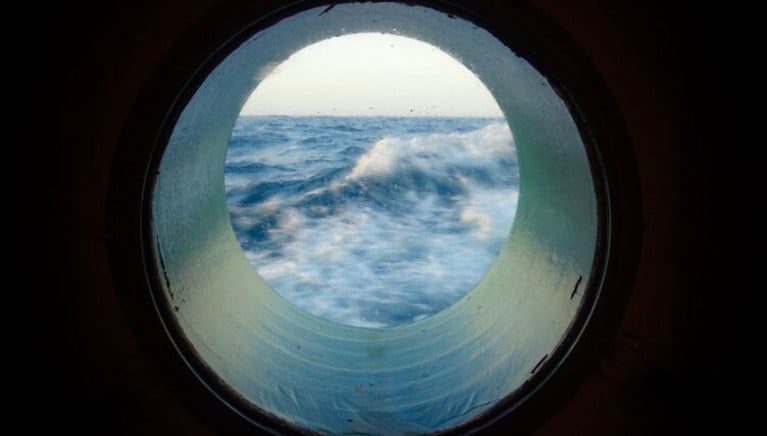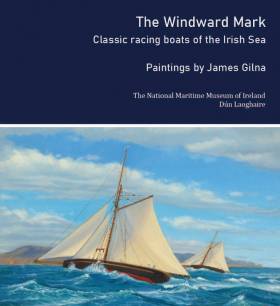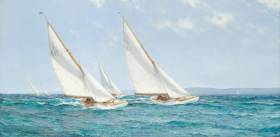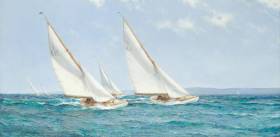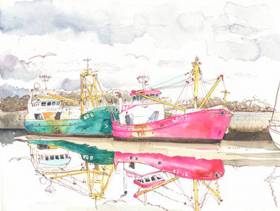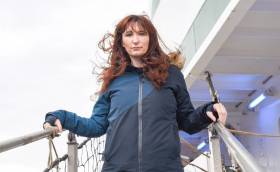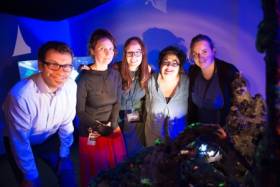Displaying items by tag: Art
A lost coastal sound will return to echo through Cork city centre for one day this January.
Found Sound (Lost at Sea) 11.1.11 is an installation by sound artist Danny McCarthy which, on Thursday 11 January, will resonate across Emmet Place outside Crawford Art Gallery and infiltrate the surrounding soundscapes of Cork.
The performance of this unique sound work commemorates the 13th anniversary of the last foghorn sounding from lighthouses along the Irish coast when they ceased on 11 January 2011.
Found Sound (Lost at Sea) 11.1.11 was created as a result of McCarthy’s interest in acoustic ecology.
The sound installation will be audible intermittently throughout the day and serves as a reminder of what was once an imperative soundtrack to daily life.
McCarthy’s work, which joined the National Collection in 2020, is unique to Crawford Art Gallery’s context. The gallery was originally built in 1724 as Cork’s Custom House and the sound work recalls its ties to the city’s commercial success, since the 18th century, as a significant port for commerce, migration, and defence.
Cork Harbour also lays claim to being one of the largest natural navigable harbours in the world and, as the city’s motto of ‘Statio Bene Fida Carinis’ announces, still offers a safe home to seafaring travellers, tourists and intercontinental shipping.
Crawford Art Gallery says it is delighted to mark the anniversary of this important work and invites visitors to stroll by the gallery on Thursday 11 January for this echo of a once ubiquitous but now lost coastal sound.
About the Artist: Danny McCarthy (b.1950) is one of Ireland’s pioneers of performance art and sound art for over 40 years and he continues to be a leading exponent exhibiting and performing both in Ireland and abroad. In 2006, he founded The Quiet Club with Mick O’Shea, a floating membership sound (art and electronics) performance group. He has exhibited nationally and internationally, and is a founding director of Triskel Arts Centre and National Sculpture Factory.
Hydrophones Dropped Off Greenland Recording Sounds of Melting Arctic Icebergs to Fuel Irish Artist’s ‘Ocean Memory’ Project
An Irish artist is part of an international expedition that’s dropping hydrophones into the waters off Greenland to record the sounds of melting icebergs.
According to the Guardian, Siobhán McDonald will use the recordings from the underwater microphones in a mixed-media installation to explore human impact on the world’s oceans.
Over the next two years, the hydrophones will capture the sounds of melting Arctic sea ice and under subaquatic audio every hour — with the results being used both in scientific research and as part of a musical score McDonald will create with a composer.
My floating studio on expedition in the deepest part of the Greenland ocean. Just passed the awesome Greenland glacier yesterday. #arctic #water #northernlights #painting pic.twitter.com/Mk8sxSgh9W
— Siobhan McDonald (@SioMcDonald) October 11, 2022
“I’m interested in hearing the acoustic pollution,” the artist says. “The sea levels are rising and that will have an impact I’d imagine on the sound range and on all the biodiversity.
“Sound is fundamental in the ocean and Arctic animals. Hearing is fundamental to communication, breeding, feeding and ultimately survival. It speaks of the necessity of paying attention to the pollution we are causing to the ecosystems around us.”
The Guardian has much more on the story HERE.
A unique whale-shaped mosaic which is set for permanent public display aims to connect present-day Wexford with its storied maritime past, as RTÉ News reports.
With the help of artist Helen McLean, Wexford Arts Centre has been creating the patterned artwork from shards of Staffordshire pottery — known as ‘chanies’ — collected from the shore at Rosslare over many decades by local woman Ann Borg.
Many of these shards are believed to originate from the wreck of a US-bound ship that went down in Moran’s Bay in the 1850s.
They have now been used to create an impression of the blue whale that famously beached in Wexford in the 1890s — the skeleton of which now hangs inside the entrance of London’s Natural History Museum.
RTÉ News has much more on the story HERE.
Connect With The Ocean Wilderness Via Art Project ‘Aerial/Sparks’ On Inis Oírr & Online
An art project involving multiple collaborators and many years in the making will soon invite the public to connect, both in person and online, with one of the last unknown spaces on earth — the ocean wilderness.
Aerial/Sparks was created by artist Louise Manifold as part of Galway’s European Capital of Culture programme for 2020, as previously reported on Afloat.ie.
Manifold brought together seven artists, writers and composers from across Europe who produced a series of standalone artworks for exhibition and radio broadcast, inspired by their experiences on research expeditions aoard the Marine Institute’s RV Celtic Explorer.
Inis Oírr, the smallest of the Aran Islands and with a deep-rooted maritime culture, is the setting for the Aerial/Sparks Art Trail from 11-27 September.
At just 3km long by 3km wide, the island can easily be traversed by foot to discover sound works housed in a lighthouse, the local church, an old handball alley and Áras Éanna, Europe’s most westerly arts centre.
Louise Manifold created Aerial/Sparks to explore the potential of radio communication to reimagine our relationship with the ocean
‘Garden Galway’ — a virtual programme of events for Ars Electronica 2020, the world-renowned festival for art, technology and society — will accompany the main exhibition from 9-13 September, and will include a series of conversations between artists and marine science experts.
Manifold created Aerial/Sparks to explore the potential of radio communication to reimagine our relationship with the ocean.
And each artist’s experience of ocean and water masses around Ireland and Europe has informed the production of individual works for audio and radio listening.
Highlights include author Kevin Barry’s ‘Island Time’, a monologue in nine chapters for a lovelorn lighthouse keeper as he dreams of distant lands, sited at Inis Oírr Lighthouse.
German composer David Stalling’s ‘Palace of Ships’ was created in collaboration with seismologist Sergei Lebedev, while visual artist Carol Anne Connolly’s acoustic portrayals of the ocean were inspired by the use of sound waves in acoustic mapping to create visuals of the sea bed.
Meanwhile, UK radio artist Magz Hall’s ‘Waves of Resistance’ is a broadcast created in the spirit of transnationalism, relaying a message of peace, hope and unity across all borders.
Manifold says Inis Oírr is the ideal home for these sound works.
“I wanted to find a place more than a space for this presentation, a place rich with silence, where organic and human sound floats and carries through the wind,” she explains. “I wanted each work to be experienced in a way that would connect with and charge our experience of place.”
Aerial/Sparks is the result of a long-term collaboration with the Marine Institute. Since 2017, artists from Ireland, Germany, England and Slovenia have taken part in seven ocean surveys and a passage from Galway to Hamburg on the RV Celtic Explorer, which the institute says is one of the few marine research vessels with sonic capabilities.
‘An innovative opportunity for artists and marine scientists to connect and engage with the wider community’
These expeditions have opened up "unique opportunities to foster connections between art and science", the Marine Institute says, as artists work side-by-side with scientists monitoring our marine biodiversity and human impact on the ocean environment.
“The collaboration between the Marine Institute and Aerial/Sparks has created an innovative opportunity for artists and marine scientists to connect and engage with the wider community through mediums such as art and music,” says Marine Institute chief executive Dr Paul Connolly.
“Using the concept of sound and the sea is a unique way of showing how both the arts and sciences can come together to highlight the value, opportunities and societal benefits of our ocean.”
Marilyn Gaughan Reddan, head of programme at Galway European Capital of Culture 2020, added: "Aerial/Sparks is a notable example of what a European Capital of Culture can bolster — new ways of thinking, new ways of working, new conversations and new partnerships.”
The Inis Oírr exhibition will be open from 11-27 September, Wednesday to Sunday between 11am and 5pm. For more information visit aerialsparks.org
Sailing Art Exhibition Opens In Dun Laoghaire — And Meet The Artist On Culture Night
A new exhibition of classic racing boat paintings by Afloat.ie reader James Gilna opens today (Wednesday 18 September) at the National Maritime Museum in Dun Laoghaire.
And the artist himself will be in attendance to discuss the works included in The Windward Mark from 5.30pm this Friday 20 September as part of Culture Night activities nationwide.
Paintings in the exhibition, which runs until Sunday 20 October, feature classic sailboats such as the Dublin Bay 21s and Howth 17s racing at Kingstown Harbour and in various locations around the Irish Sea.
A maritime artist based in Dublin, James Gilna is an alumnus of Dun Laoghaire School of Art and Design and the National College of Art and Design. He also sails and races Erica, his classic gaff rigged boat which was designed in 1897.
Earlier this year, Gilna tipped us to the auction of a painting by renowned maritime artist Montague Dawson of a boat supposedly racing on Lough Derg.
The events depicted in the painting were subsequently questioned by a Lough Derg yachting historian, who raised a number of points where Dawson may have taken artistic licence with his work.
Lough Derg Historian Questions Montague Dawson Painting Of Corinthian Race Sold At Auction
A painting by Montague Dawson recently sold at auction may not depict an amateur sailing race on Lough Derg as claimed, according to one yachting historian.
As previously reported on Afloat.ie, the painting titled ‘Racing for the Corinthian Challenge Cup on Lough Derg’, by the renowned maritime artist, fetched more than €87,000 in the Marine Sale at Bonhams in London last Wednesday (1 May).
The auctioneers confess that “it has not yet been possible to identify the specific race and those yachts depicted”.
But that could be because the race never happened, an expert on Lough Derg has suggested.
In correspondence seen by Afloat.ie, Vincent Delany — a member of the Association of Yachting Historians, author of a definitive history of Lough Derg’s yacht clubs, and a regular contributor to Afloat.ie — identified a number of reasons why he believes the painting takes artistic licence with its title.
Among them are the sail numbers, when Lough Derg boats used house flags; the size of the boats depicted, when there were no six-metre yachts on the lough; and the background, which is “not reflective of the hills of Co Tipperary, or of Cos Clare or Galway or the eastern shorelines of Lough Derg”.
Delany also posits that the quality of the lighting in the painting is more suggestive of the south of England than the lakes of the Shannon.
Afloat.ie awaits Bonhams’ response to Delany’s questions.
A painting by a renowned maritime artist of yachts racing on Lough Derg has fetched more than €87,000 at auction.
Afloat.ie reader James Gilna tipped us to the sale of ‘Racing for the Corinthian Challenge Cup on Lough Derg’ by Montague Dawson, which was auctioned last Wednesday 1 May at Bonhams in Knightsbridge, London.
There is some mystery surrounding the painting, which had been in a private collection since its original sale in 1984, as according to Bonhams “it has not yet been possible to identify the specific race and those yachts depicted”.
But regardless, the “spirited” work will surely bring much enjoyment to its new owner as one of the more lively examples of the famed maritime painter, whose patrons included the British royal family and two US presidents among many others.
Capturing The Importance Of The Ocean For Irish & Welsh Coastal Communities Through Art
A series of watercolour illustrations and interviews have captured the importance of the ocean to coastal communities in Ireland and Wales as part of the EU-funded BlueFish Project.
Sharon Sugrue, scientific and technical officer at the Marine Institute, and Galway’s urban sketcher Róisín Curé visited coastal communities in Ireland and Wales that border the Irish and Celtic Seas.
They met with people from a broad spectrum of marine activities including fishing, aquaculture, leisure, transport, tourism and marine renewable energy.
“A key aspect of the project was speaking with people living and working in coastal communities, and gathering their opinions about climate change and learning about how it might affect their livelihoods,” Sugrue said.
“Along with interviewing people and documenting their daily interactions with the sea, the medium of art was also used to record their activities. This was a unique opportunity to talk directly to coastal communities and capture their perspectives through art.”
Róisin Curé produced a series of watercolour illustrations that captured snapshots of these coastal communities and people’s daily lives.
The results of the interviews and art, through watercolour illustrations, created an accessible way for the public to understand the importance the ocean has on livelihoods in coastal communities.
By engaging with people and industries dependant on the sea, the information gathered highlighted how they benefit from the ocean, their thoughts on climate change, and particularly how it was going to affect their lives and businesses.
Comments made by fishermen stated that without the ocean, they wouldn’t have a living, as it’s their only source of income in their rural parts of Ireland.
“Many of the stories reaffirmed the importance of the age-old relationship between people and the sea, noting that the sea is the life-blood which sustains these communities,” Sugrue said.
“The general consensus in both Ireland and Wales coastal communities was that climate change is happening. There was an acknowledgment and a realisation amongst the people interviewed that there was a real looming threat to their livelihoods.”
Many people commented on how they were seeing changes to their climate in their local communications. A local businessman from Anglesey said: “In the 38 years I’ve been working here, the road would have flooded twice a year. Now it floods much more often.”
Curé said: “I felt privileged to sketch, at close quarters, people whose ingenuity has turned a potentially hostile ocean into a source of income. I hope that the same ingenuity will provide the answers to the challenges we’re facing with the effects of climate change.”
In August 2018, the ports of Dingle in Co Kerry, Baltimore in Co Cork, Kilmore Quay in Co Wexford and Howth in Co Dublin were visited and fishermen, restaurateurs, shellfish producers, operators in the tourism sector and seafarers were interviewed.
The Welsh coastal communities were visited in October and included Anglesey, Bangor, Pwllheli, New Quay, Milford Haven and Pembrokeshire.
Sugrue added: “This project has given me the opportunity to engage with those living and working in coastal communities in a personal and hands on way.
“Growing up by the sea and being part of a family business in aquaculture, I felt an affinity with the people interviewed. It also brought home to me the effect that climate change could have in a ‘real sense’ showing how these effects could ripple through these communities.”
Linking science and art as a mechanism to convey the importance of the ocean to coastal communities and the potential impacts of climate change on these communities will continue throughout 2019, where the project will feature at maritime festivals in Ireland and Wales and continue the dialogue with these coastal communities.
The BlueFish Project is a partnership between six organisations in Ireland and Wales including the Marine Institute, University College Cork, Bord Iascaigh Mhara, Bangor University, Aberystwyth University and Swansea University.
The marine science research project is funded by the Ireland Wales 2014-2020 European Territorial Co-operation (ETC) Programme. The purpose of this maritime programme is to connect organisations, businesses and communities on the West coast of Wales with the South- East coast of Ireland.
Through engagement with coastal communities and art, the BlueFish Project, launched in September 2017, aims to develop knowledge and understanding of the marine resources and the potential impacts of climate change on the Irish and Celtic Sea ecosystem.
To find out more about the BlueFish Project, visit BlueFishProject.com
#MarineScience - As many as 12 artists, writers and musicians from Ireland and Europe have the opportunity to join expeditions on the research vessel RV Celtic Explorer and to work with marine scientists as part of an interdisciplinary art project for radio broadcast.
The three-year AerialSparks project will explore the potential of radio communication as a means to rethink our ocean wilderness as one of the last remaining unknowns.
AerialSparks has been created by artist Louise Manifold for Galway’s European Capital of Culture programme in 2020. Inspired by the concept of traditional broadcasting and the use of sonar and other technology for data collection, the project will result in a series of art works for radio.
Manifold, who previously worked with Galway schoolchildren on marine science and art projects, has commissioned artists from Ireland and Europe to develop new work based on their experiences of spending time at sea on research surveys carried out by the Marine Institute's research vessel, RV Celtic Explorer.
The Galway-born conceptual artist, currently on residency in Berlin, is keen to tap into the connections between radio as a communication and navigation tool, and discover how radio can make spaces visible to audiences.
“While at sea on the Explorer last year, I was extremely mindful of how radio can be listened to in solitude, yet bring people together providing a sense of togetherness,” she said. “It is amazing to think how early radio technology must have felt for many people bridging the distance of the ocean and bringing people together. Recognising the importance of technology, it continues to play a big part in how we understand the influences of the ocean.”
Taking part in the project are renowned artists David Stalling, Kennedy Brown, Carol Anne Connelly and Ailís Ní Riain, who will each spend up to two weeks at sea on the RV Celtic Explorer during scientific expeditions.
One of the surveys, overseen by Prof Andy Wheeler from UCC, includes monitoring deep-water coldwater corals reefs off the continental shelf, exploring the processes involved in understanding the coral habitats and sensitivity to climate change and human impacts.
The artists will have the opportunity to record data where advanced robotic technology and 3D visualisation tools will be used on the ROV Holland I at depths of 3,000m under the water.
Ireland’s offshore territory is 10 times the size of our land area, and marine research projects involving new technology help us learn more about the land under the sea, its geology and processes and how this impacts our lives.
Artists will also get to work with Prof Sergei Lebedev from the Dublin Institute for Advanced Studies (Dias), where research is being conducted looking at offshore earthquakes in the deepest parts of Ireland’s ocean.
With scientific equipment being deployed for the first time from the RV Celtic Explorer, including 18 ocean-bottom seismometers and an array of acoustic sensors, the survey will explore marine activity that can trigger undersea landslides.
Hannah Kiely, chief executive of Galway 2020, said of the project: “We are very excited about the waves of possibilities that the collaboration between arts and science presents particularly given the project’s focus on histories of the ocean voyage, maritime radio communication and how this might be felt and understood in a digital age. With our aim to be the first truly Virtual European Capital of Culture, digital is at the heart of our programme for Galway 2020.”
The ocean covers over 70 percent of the planet’s surface and with the advancement of marine technology, new discoveries are being made every day.
Marine Institute chief executive Dr Peter Heffernan added: “Aerial Sparks is an innovative opportunity for artists and marine scientists to learn new ways to connect and engage with the wider community.
“We are learning more about the ocean including new habitats being explored for the first time, new species being discovered, as well as the effects of climate change and understanding the impacts humans are having on the ocean.
“Therefore, increasing our awareness and narrative about the ocean is extremely important. Using the concept of sound and the sea is a unique way of showing how both the arts and sciences highlight the importance of exploration and curiosity.”
The Marine Institute is also hosting a series of lunchtime talks at its Galway headquarters for scientists, giving them the opportunity to meet artists working on the project, and to be introduced to their ideas, processes and future work for AerialSparks. For further information contact the research operations office at the Marine Institute.
AerialSparks is funded by the Arts Council of Ireland Project Awards, Galway 2020 and the Marine Institute.
Primary School Marine Science Art Project Shortlisted For Top Award
#MarineScience - Build Your Own Unknown, a marine science and art project by fourth-class pupils at Cregmore National School in Co Galway, has been shortlisted for the Allianz Business to Arts Awards.
As previously reported on Afloat.ie, the Cregmore pupils worked with artist Louise Manifold to produce their installation and short film, using images and footage from the ROV Holland I for inspiration in recreating the discovery of the Moytirra deep-sea hydrothermal vents in 2011.
The project — which places art, marine science and technology in the heart of the classroom — also involved TULCA in partnership with the Marine Institute’s Explorers Education Programme and marine scientist Dr Andy Wheeler from UCC.
Marine Institute chief executive Dr Peter Heffernan congratulated the team on their achievement and wished them luck for awards night.
“One of the greatest outcomes of the Build Your Own Unknown project was being able to provide an opportunity for artists, marine scientists and educators to work together to help engage and increase children, teachers and the wider community’s awareness about the importance of our ocean,” said Dr Heffernan.
The Allianz Business to Arts Awards recognise and champion the spirit of collaboration between businesses, artists and arts organisations that develop creative partnerships; bringing the arts and artists into mutually beneficial relationships across society.
The winners of this year’s Allianz Business to Arts Awards will be announced later this evening (Monday 4 September).


























